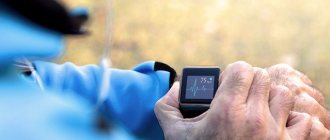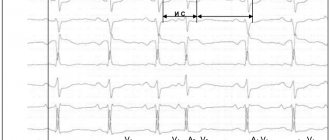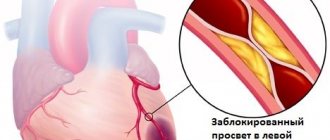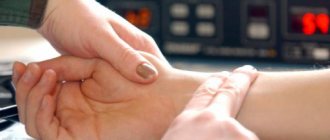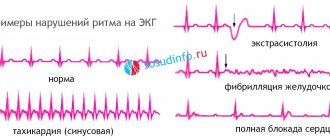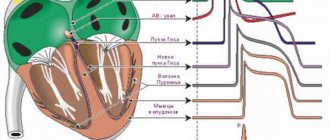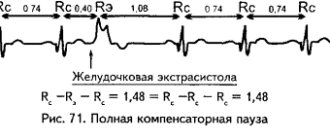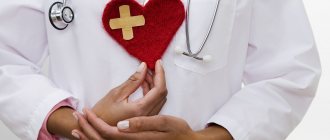Patients are often diagnosed with a condition such as extrasystole. This is the name for a type of heart rhythm disorder in which ectopic rhythm of the organ occurs. The forms of extrasystole are bigeminy, quadrigeminy and trigeminy. What is the cause of the last type of pathology?
The mechanism of pathology development
In the normal state of the body, cardiac structures contract autonomously. This gives the body some margin of safety to maintain the minimum necessary activity in emergency cases when consciousness is switched off or the brain is damaged.
The so-called sinus node is responsible for the production of an electrical signal that excites the muscular structures of the myocardium. It is located in the upper part of the organ.
The ventricles and atria are not normal; they only conduct the impulse, they do not create it themselves. In the case of bigeminy, pathological activity occurs in these structures. As the name suggests, for every normal contraction there is one abnormal contraction (extrasystole).
Such alternation is clearly visible on the ECG, which makes diagnosis, even in the early stages, relatively simple.
It is impossible to talk about the severity and prospects of the process based on just one factor. Much depends on the location of the anomaly (atrial forms of extrasystole almost never pose a danger, which cannot be said about ventricular ones). The underlying disease, general state of health, and the moment of contacting a doctor also play a role.
As already said, deviation is not primary. It is secondary to cardiac diseases, less often to non-cardiac pathologies.
Which one needs to be looked at during the diagnosis. Usually these are congenital and acquired defects, hormonal imbalances, bad habits that provoke temporary or permanent changes in the functioning of the whole organism, etc.
What are bigeminy and trigeminy
The most common types of allorhythms are:
- Bigeminy is the occurrence of extrasystole after each normal contraction.
- Trigeminy - the appearance of extrasystoles after two contractions or two extrasystoles after one contraction.
In order for the heart to contract and relax, an electrical impulse is required, which is normally generated in the sinus node.
Attention. When there is bigeminy/trigeminy, this does not happen, since the impulse does not come from the sinus node .
For these pathological conditions, the pacemaker is other foci. According to this principle, all bigeminia are divided into two types:
- Ventricular bigeminy - impulses are produced by the ventricle. Most common among older people. In most cases it is accompanied by organic lesions of the heart.
- Supraventricular (supraventricular) - impulses come from the atrioventricular node or atrium. This type is often characteristic of young people, the causes of which can be severe physical activity and stressful situations.
The formation of extrasystoles in a healthy person is allowed, the number of which per hour can be from 30 to 60 (from 700 to 1400 per day).
For reference. There are quite a lot of factors that influence heart rhythm and premature excitation, and correctly identifying the cause will help in the future to choose the right tactics for treating and monitoring patients.
Classification
The basis for typing a pathogenic manifestation is the localization of the rhythmic deviation.
Accordingly it happens:
- Atrial bigeminy. As the name suggests, the signal develops in the upper chambers of the cardiac structures. Symptoms of this phenomenon are minimal or completely absent.
Since the risks are also not significant, many live for many years without even suspecting that they have health problems.
The likelihood of complications is extremely low; incidental findings are not subject to treatment. Long-term follow-up is indicated.
In the absence of manifestations and organic defects throughout the entire period, we can say that the person is relatively healthy.
- Ventricular bigeminy. It occurs more often (approximately 55% of recorded cases). Potentially threatens patients, but it is impossible to accurately predict the risks right away. A lengthy examination is required. Only the leading specialist can give specifics. In general, the indicators for patients even with this type of arrhythmia are positive.
The classifications have minimal clinical significance. Basically, the tactics of diagnosis and symptomatic treatment are identical.
Features of the violation
A large group of arrhythmias, when a rhythm disturbance occurs due to the presence of extraordinary contractions of the heart, called extrasystoles, is united by the concept of extrasystole. Extrasystoles do not occur due to the impulse of the pacemaker, but are caused by impulses from ectopic foci.
Varieties of this disorder include arrhythmias, which differ in the number of extraordinary contractions occurring between normal heartbeats - allorhythmias. If each normal contraction is followed by one extrasystole, then this is a sign of bigeminy.
The danger of deviation from the norm in the rhythms of the heart is determined by the cause that creates this situation. Analyzing how deep the problem is that creates the arrhythmia, and whether it can be eliminated, will indicate whether bigeminy is worth worrying about.
Read on to learn about the classification of this heart rhythm disorder as bigeminy.
Diagnosis of bigeminy
Causes
Developmental factors are not always of cardiac origin. Extracardiac moments are possible, which imposes increased demands on the qualifications and experience of the specialist.
Sample list:
- Overdose of cardiac glycosides. As a last resort. Long-term use of such drugs is possible. They stimulate myocardial contractility through artificial means, without taking into account the organ’s strength reserves. At a certain point, a failure and episodes of bigeminy may occur. These are dangerous medications, they are prescribed only by a doctor, in small courses.
- The use of aminophylline, corticosteroids in significant dosages or on an ongoing basis. In this case, allorhythmia of the bigeminy type mainly affects asthmatics, severe allergies, and patients with hormonal pathologies.
- Abuse of antipsychotics and mood stabilizers.
- Inflammatory, infectious diseases with severe intoxication and hyperthermia. In such a situation, the phenomenon is temporary. The main form is ventricular bigeminy. Detoxification, rhythm restoration, and maintenance of cardiac stability are required. The risk of complications depends on the severity of the infectious pathology. The main danger is cardiac arrest.
- Long-term use of hormonal drugs. This is the “sin” of young women when they use birth control pills (oral contraceptives). Usually, everything that can be found in the pharmacy is used, without medical advice or following the rules of common sense. The price for such amateur activities is high. Stopping medications alone is often not enough. Organic transformations begin. A “bonus” is persistent hormonal imbalance, fertility, and general manifestations of the central nervous system.
- Recent heart surgery. The phenomenon is temporary, but that is why staying in a hospital for at least a week is indicated. Then you need to regularly “visit” the cardiologist for dynamic monitoring.
- Heart attack. Necrosis of the muscular structures of the heart. It is impossible to say how it will end for a particular patient. Need to watch. Bigeminia is the least dangerous option because it is potentially treatable and reversible.
- Long-term exercise, especially professional sports. Cardiomyopathy occurs, which is dangerous after a person stops physical activity. Sudden death or heart attack is possible.
- Arterial hypertension stages 2-3 and its more severe variants with a persistent increase in tonometer readings. Causes stress on cardiac structures. In younger years, the body’s resistance to negative factors of this kind is greater; with age, the risks increase. It is necessary to be treated in a timely manner, since organic tissue transformations occur against the background of hypertension.
- Inflammatory pathologies of the heart and cardiac sac. Myocarditis, pericarditis. They have an infectious, less often autoimmune origin. They are treated urgently, in a specialized department of the hospital.
- Cardiomyopathy. Any type: dilated congenital, toxic, alcoholic. It is a violation of the size of the heart. This is mainly hypertrophy of the muscle layer. Less common is an increase in chamber volumes.
Regardless of the type, the essence is the same - decreased myocardial contractility, weakened hemodynamics, ischemia, multiple organ failure, death from complications, and extrasystole of the bigeminy type is part of the clinical picture.
- Genetic syndromes. They manifest themselves not only as heart problems.
- Increased pressure in the pulmonary artery (pulmonary hypertension) and the formation of specific syndromes.
- Replacement of cardiomyocytes with scar tissue cells. Cardiosclerosis occurs against the background of a heart attack, inflammation, ischemic heart disease, and other destructive processes.
- Chronic heart failure.
- Endocrine problems (with the thyroid, pancreas or adrenal glands).
It is not easy to understand such a mass of phenomena. A comprehensive diagnosis is required. It begins with the exclusion of cardiac conditions themselves. Then other specialists are involved.
The ventricular type is caused by heart problems. IHD is considered the absolute record holder, and arterial hypertension is somewhat less common. In third place is a heart attack.
These conditions cover 85% of all cases presented. If the cause remains unclear, then they speak of idiopathic bigeminy.
How is bigeminy diagnosed?
In the absence of subjective sensations, bigeminy will be an incidental finding on an ECG or Holter monitoring. The doctor may suspect a heart rhythm disorder after collecting the patient’s complaints: episodes of loss of consciousness, dizziness, chest pain, a feeling of fading or interruptions in the heart, cardiac tremors with a feeling of heaviness in the neck. During cardiac auscultation, extrasystoles are heard as extraordinary tones followed by a compensatory pause.
Palpation of the pulse does not always make it possible to feel an ectopic contraction, since the pulse wave it creates is usually of weak filling.
An ECG provides a graphical representation of the electrical activity of the heart, where extrasystoles of the bigeminy type will be presented as follows:
- Supraventricular type - an extraordinary narrow QRS complex (less than 0.12 seconds) with a preceding P wave and a partial compensatory pause.
- Ventricular type - extraordinary QRS complex (wider than 0.12 seconds) without a P wave in front of it. The compensatory pause is complete.
In addition to the 12-lead resting ECG, the patient is referred for other studies in order to clarify the nature of the rhythm disturbance, the cause of the arrhythmia, and determine the treatment strategy for the patient. Additional diagnostic methods include:
- General blood test (determining the content of formed elements, hemoglobin, ESR).
- General urine test (to exclude kidney pathology).
- Biochemical blood test: determine the sugar level and lipid spectrum (total cholesterol, low and high density lipoproteins, triglycerides), it is advisable to examine the function of the hepatobiliary system (bilirubin, liver enzyme activity) and thyroid gland (TSH, thyroxine, triiodothyronine, antibodies to thyroid peroxidase).
- Holter-MT. Daily ECG monitoring with mandatory recording of physical activity and medication intake. For a more complete study, an ECG is taken over 2 days and combined with hourly blood pressure measurements.
- Echo-KG. Ultrasound method for visualizing the parts and valve structures of the heart. It is advisable to combine it with Doppler diagnostics to assess cardiac blood flows.
- ECG with exercise tolerance tests (bicycle ergometry, treadmill test, 6-minute walk test). These tests allow, in addition to identifying extrasystoles, to assess the level of heart failure.
- X-ray of the chest organs. In addition to flat image data of the lungs, mediastinum and heart, this study allows you to evaluate circulatory failure, namely blood stagnation in the pulmonary vessels.
For a full examination for arrhythmias, in addition to a general practitioner, you should visit a cardiologist-arrhythmologist, a neurologist, an endocrinologist and an ophthalmologist. Each specialist will help eliminate the presence of chronic pathological processes in the body.
Symptoms
Bigeminy itself has no manifestations, since it is a sign of a pathological process. We can only talk about the accompanying moments.
The average clinical picture is as follows:
- Disturbances of normal rhythm. Especially common. Subjectively, it is felt as alternating, periodic skipping of beats, different intervals between contractions, heaviness in the chest. A parallel course of tachycardia is possible. Athletes have a slower rhythm.
- Pain. Not observed in all cases. Moreover, determining the source of discomfort is not so easy even for a specialist.
- Dyspnea. Occurs against the background of an advanced pathological process. First, during a period of physical activity that can be called intense for a particular person. Then the patient cannot perform daily duties at all. The latter option is associated with disability and almost total exclusion of a person from professional activities.
- Darkening in the eyes. As a result of an attack of palpitations or rhythm disturbances.
- Pallor of the dermal layers.
- Sweating.
- Syncope. Fainting.
- Headache, vertigo, nausea and vomiting (rare).
- Feeling of weakness, body wobbliness, drowsiness.
The clinical picture grows like a snowball as the anatomical abnormalities progress. They are extremely rarely caused by bigeminy itself. The culprit is the underlying disease.
Persistent, ventricular, asymptomatic trigeminy of the heart: treatment, episodes, causes
Patients with heart rhythm disturbances often do not attach importance to their condition, meanwhile, pathologies can lead to serious consequences even with a benign course. One of these pathologies is trigeminy.
Peculiarities
Trigeminy is a heart rhythm disorder in which the heart or its individual parts contract out of sequence. The disease itself usually has a benign course and does not pose any particular danger to the patient. However, without proper treatment, the pathology can become more complicated.
The International Classification of Diseases differentiates trigemy by code I49.4, that is, it is classified as “other and unspecified premature depolarizations.”
How do episodes of bigeminy and trigeminy relate to each other? Trigeminy differs from other forms of allorhythmia in the ratio of alternation of normal contractions with extrasystolic ones. So, with bigeminy this ratio is 1:1, and with quadrigymeny it is 3:1, where 3 is normal contractions. According to the form, the causes of the pathology change, and slight differences in symptoms are also observed.
Read on to learn about persistent, asymptomatic and other types of trigeminy.
Trigeminy on ECG
By localization
The main classification distributes trigemy by localization into:
- ventricular;
- atrioventricular;
- atrial;
- combined, that is, combining several types of localization;
Very rarely, in approximately 0.3% of cases, trigeminy can originate from the sinoatrial node.
According to cycle ratio
Trigemyny can develop in 2 ways:
- After 2 cycles of OR, an extrasystole appears, and this process will be repeated many times. To simplify, sinus and extrasystolic cycles alternate in a 2:1 ratio.
- Extrasystole occurs 2 times in a row after the OP cycle. That is, the ratio of sinus and extrasystolic cycles changes to 1:2. This option is the most difficult.
By frequency of manifestation
The pathology is also classified according to the frequency of manifestation into:
- frequent, occurring more than 30 times per hour and more than 720 times per day, respectively;
- medium, occurring 6-15 times per minute;
- rare, occurring less than 5 times per minute;
There is a classification based on the number of ectopic foci, distinguishing a monotopic form with one foci and a polytopic form with several.
Causes of trigeminy
The causes of trigemy are divided by genesis:
It is noteworthy that functional trigemy can also develop in healthy people, for example in women during menstruation or in people of both sexes due to excessive coffee consumption. This trigemy is called idiopathic. However, it goes away on its own when the provoking factors are eliminated.
The main symptom of trigeminy is a feeling of a malfunction of the heart. In a normal state, we do not feel heartbeats, but with trigeminy, there is a clear sensation that the heart is beating outside of the heart.
This condition is also accompanied by:
- weakness;
- fatigue;
- shortness of breath;
- lack of air;
- panic;
- fear of death;
- dizziness;
- sweating;
In rare cases, fainting may occur. Read on to find out whether trigeminy can be detected on an ECG, as well as other methods for diagnosing it.
Diagnostics
Trigeminy is often diagnosed accidentally, since it does not cause any particular discomfort for the patient. However, if the patient purposefully came to determine the cause of his symptoms, then the examination begins with standard procedures: collecting anamnesis of complaints, family and signs, examination and auscultation.
After analyzing the study results, additional laboratory tests are prescribed, for example:
- General and biochemical blood and urine tests, as well as a blood test for hormones. All these studies help to establish the possible causes of the pathology.
- ECG. The most accurate diagnostic method that detects changes in the functioning of the heart.
- Holter monitoring ECG. Allows you to identify irregular heart rhythm disturbances, for example, during physical activity.
- EchoCG. Identifies heart diseases that could cause trigeminy.
- Stress tests to identify arrhythmia that appears during physical activity.
The most accurate diagnostic method is MRI, which visualizes the heart muscle. However, this is an expensive study, and not every hospital has the necessary equipment.
Read below about the treatment of ventricular and other types of trigeminy.
Therapeutic
The therapeutic method may be the only method of treatment if the patient does not have diseases of the heart muscle or endocrine system. It consists in:
- maintaining a rest regime;
- balanced nutrition;
- avoiding stress and excessive physical activity. loads;
It is also important to spend more time in the fresh air and constantly monitor your pathology through periodic examinations.
Medication
Drug treatment is prescribed if the number of extrasystoles exceeds 200 per day. The following drugs can be used to treat trigeminy:
- antiarrhythmic drugs;
- cardiac glycosides;
- antihypertensive drugs;
Each drug is selected individually, using Holter monitoring.
Operation
Surgery is prescribed only if there is extensive damage to the heart and there is no response to drug treatment:
- Open with removal of ectopic foci.
- Radiofrequency ablation on ectopic lesions with the introduction of electrodes that cauterize the pathological area of the muscle.
Other types of surgical intervention are determined together with the doctor.
Folk remedies
Trigeminy is one of the diseases that responds well to folk remedies. The most effective remedy is valerian, preferably in the form of tablets or a self-prepared infusion.
The infusion is prepared according to the following scheme: tea. l. Valerian is brewed with a quarter glass of boiling water and infused until it acquires a dark shade. After this, add water to the infusion to half a glass, and then take 1 r. per day for 10 days. After a break of a week you can repeat.
You can also use:
- Melissa infusion. Chain. l. herbs are infused in 250 ml of hot water and taken before meals for 3 months.
- Radish juice with honey. Grated black radish is mixed with honey in a 1:1 ratio and eaten 1 teaspoon. spoons before each meal.
Herbs are also useful in treatment:
- mint;
- hyssop;
- hawthorn;
- calendula;
You can use alcohol tinctures, as they dilate blood vessels and lower blood pressure.
Prevention
Preventive measures consist of following the principles of a correct lifestyle. Important:
It is equally important to undergo regular preventive examinations, monitor blood pressure and immediately consult a doctor at the first symptoms.
Complications
Sometimes trigemynia can develop into more serious heart rhythm disorders such as:
- atrial flutter;
- paroxysmal tachycardia;
- atrial fibrillation;
Ventricular trigeminy can progress to ventricular fibrillation and sudden death.
Forecast
The prognosis for trigemy is relatively positive if it does not develop against the background of other heart pathologies, for example, cardiomyopathy, myocardial infarction, etc. Usually, the pathology is benign.
Source: https://gidmed.com/kardiologiya/kardioterapiya/aritmii/trigeminiya.html
Complications
Terrible in nature, but again due to extrasystole, they rarely occur. The greatest danger is posed by the ventricular type.
Possible consequences include:
- Heart failure. Perhaps the main cause of death for patients of all ages. With proper resuscitation, you can bring a person back to life.
- Cardiogenic shock. As a result of a generalized hemodynamic disorder or severe infarction. Recovery is possible in an extremely limited number of cases, and even then no one can guarantee the absence of relapse. Mortality rate is almost 100%.
- Fainting and subsequent injury.
- Stroke. Acute cerebrovascular accident, death of nerve tissue.
- Vascular dementia. It is similar to Alzheimer's disease, but has a relatively benign course and has prospects for reverse development.
- Heart attack. Necrosis of cardiomyocytes, replacement of functional structures with connective and scar structures.
- Multiple organ failure. Over time, as distant systems do not receive enough blood.
Complications are potentially fatal, but can be avoided with timely medical care.
Types of trigeminy
Trigeminies vary depending on the location of the focus of premature excitation. In accordance with this, supraventricular and ventricular trigeminies are distinguished.
The source of supraventricular trigeminy is a focus of premature excitation located in the conduction system of the heart above the branching point of the His bundle. This area includes the structures of the conduction system passing through the thickness of the atrial myocardium.
Ventricular trigeminy develops due to the occurrence of a premature impulse below the branching point of the His bundle. Typically, the sources of extrasystole are Purkinje fibers penetrating the ventricular myocardium.
Supraventricular trigeminy: what is it?
The cause of the development of supraventricular trigeminy is a pathological impulse that occurs in the structures of the conduction system of the heart located in the region of the atrial myocardium. From a clinical point of view, this type of arrhythmia may not manifest itself in any way, however, most patients present complaints such as:
“Interruptions” in the work of the heart. Feeling of “turning over” in the chest. General discomfort, anxiety.
Some patients also describe shortness of breath, dizziness, and chest pain that occurs during an episode of extrasystole. These symptoms, however, are due to an autonomic reaction rather than significant circulatory disorders.
On the ECG, supraventricular trigeminy is characterized by premature QRS complexes with preceding P waves, as well as an incomplete compensatory pause. An extrasystole occurs every two normal heartbeats. To clarify the diagnosis, Holter monitoring is required.
Supraventricular trigeminy usually does not require special treatment. In some cases, the patient is indicated for antiarrhythmic therapy with beta blockers or calcium antagonists, as well as sedatives, since this type of arrhythmia very often accompanies mental and psychosomatic disorders of a neurotic level.
Ventricular trigeminy
Ventricular extrasystole of the trigeminy type develops as a result of premature excitation, the source of which is the myocardium of the ventricles of the heart. This type of arrhythmia, much more often than supraventricular extrasystole, occurs against the background of structural changes in the cardiovascular system, which leads to other therapeutic approaches.
The clinical picture of ventricular trigeminy is similar to that of supraventricular trigeminy, however, objective symptoms of arrhythmia are often identified:
Irregular pulse. Uneven pulsation, determined by palpation of the apex of the heart. On auscultation, a premature heartbeat with a characteristic loud first sound is heard.
Ventricular trigeminy is much more often accompanied by shortness of breath, weakness, dizziness and chest pain.
Ventricular trigeminy on ECG
In typical cases, the electrocardiographic characteristics of ventricular trigeminy include:
Presence of premature QRS complexes without preceding P waves. QRS complexes are widened (more than 0.12 sec), deformed, and may resemble a bundle branch block. The presence of a complete compensatory pause.
Extrasystole occurs every two normal contractions (allorhythmia type trigeminy). To clarify the diagnosis, Holter monitoring is required, which can detect a combination of bigeminy and trigeminy, as well as other disturbances of cardiac rhythm and conduction.
Ventricular trigeminy: treatment
Treatment of ventricular trigeminy is no different from that for any other forms of ventricular extrasystoles. Treatment of the underlying cardiac disease is mandatory in order to compensate and stabilize the condition.
In the treatment of ventricular extrasystole of the trigeminy type, various classes of antiarrhythmic drugs are used. The choice of a specific remedy depends on the general condition of the patient and the form of ventricular trigeminy.
A cardiologist treats heart diseases. From choosing a specialist
life depends
and patient health.
Want to find
the best cardiologist
In your city?
Take advantage of the doctor rating, which is based on patient reviews.
Select your city of residence
Diagnostics
It is carried out under the supervision of a cardiologist as a specialized specialist. Due to the complex nature of the process, it is possible to involve third-party doctors in the work. But only after ruling out heart problems.
The main examination looks like this:
- Oral interview, history taking.
- Measuring blood pressure and heart rate using routine methods.
- Daily monitoring. Used for more accurate assessment.
- Electrocardiography. Basic method. Aimed at identifying bigeminy and other clinical variants of rhythmic disorders.
- Load tests. They are carried out with great caution; complications are possible with increased activity.
- General blood test, biochemical.
- Coronography.
- If necessary, MRI or (less often) CT.
As part of the advanced diagnostics, hormonal studies, assessment of neurological status, ultrasound of the adrenal glands, scintigraphy of the thyroid gland, measurement of daily diuresis, urine analysis, and other techniques are indicated.
The complexity of the examination necessitates an integrated approach. The duration can reach a week or even more.
Treatment options for bigeminia
The main method of treatment at the early stage of pathology is drug therapy, which helps suppress the symptoms of rhythm disturbances by prescribing antiarrhythmic medications. When selecting drugs, you should take into account the degree of risk of consequences of supraventricular (atrial) bigeminy:
- development of supraventricular tachycardia with an increase in heart rate to 180 beats per minute, which requires urgent measures;
- the appearance of atrial fibrillation, which is accompanied by an alarming frequency of atrial contraction (over 300 beats).
Atrial fibrillation on ECG
If blood flow through the body's systems is disrupted and there is an increased risk of death, surgical intervention cannot be ruled out. During the operation, the source of arrhythmia is destroyed by radiofrequency exposure of the organ.
Therapeutic measures
After identifying the factor provoking bigeminy, they begin to eliminate the cause that caused the interruptions in heart rhythm. According to the standard program, extrasystole is treated with the following medications:
- by prescribing beta-blockers, blood pressure levels are normalized along with the heart rate equalization (“Propranolol”);
- to protect against the appearance of blood clots, drugs that block platelet aggregation, antiplatelet agents (“Dipyridamole”);
- increased excitability of the nervous system and manifestations of nervousness are suppressed with sedatives (“Phenazepam”);
- To reduce heart rate, it is important to take calcium channel blockers that dilate blood vessels (Amlodipine);
- stabilization of vascular tone, equalizing blood pressure and heart rate, is achieved by prescribing potassium and magnesium in tablets (“Asparkam”);
- the addition of nitrates is justified in case of sudden pain syndrome, which is suppressed by “Nitroglycerin”;
- To urgently reduce blood pressure and heart rate, they use ACE inhibitors such as Captopril tablets.
It is forbidden to take medications on your own; a cardiologist selects medications based on the patient’s individual condition. In case of rare occurrence of extrasystoles of a functional rather than organic nature, instead of treatment, it is sufficient to follow the general recommendations of the doctor:
- exclude high physical activity, as well as stressful situations;
- give up all bad habits, do not abuse coffee;
- provide a proper diet with limited salt and animal fats;
- do not neglect moderate exercise and walking.
Important: If there is a sudden appearance of threatening symptoms or poor tolerance to arrhythmia attacks, the patient requires emergency assistance. Emergency treatment for bigeminia is carried out by intravenous infusion of Quinidine, Cordarone, Lidocaine, which help normalize the heart rate.
When is heart surgery needed?
The basis for prescribing surgical intervention using radiofrequency ablation is intolerance to antiarrhythmic drugs or the low effectiveness of drug therapy. During a minimally invasive operation performed in a hospital under local anesthesia, the focus of the extrasystole is cauterized by exposure to radio waves.
A surgical procedure performed under the control of fluoroscopic equipment is prescribed only after prehospital identification of the location of the source of pathological impulses. Access of electrodes to the source of arrhythmia is achieved by catheterization of the femoral vein, which ensures insertion of the instrument.
Help from traditional methods
The treatment program for mild forms of extrasystole can be enhanced by incorporating folk recipes. They help restore the nervous system by eliminating neurological symptoms, improve the condition of blood vessels and help restore normal heart function, saturating the body with useful elements.
At home, you can prepare healing infusions from well-known medicinal plants, which are taken 15-20 minutes before meals:
- Hawthorn. A tablespoon of fruit is crushed, poured with a glass of boiling water and simmered over low heat for 15 minutes. After infusion, filter the decoction and take a teaspoon 3 times a day.
- Valerian. A tablespoon of carefully crushed root is poured into a glass of boiling water. The drug is infused, covering the container with a lid, then filtered. Take 3 times a day, ½ cup.
- Calendula. Dried flowers of the plant (70 g) are steamed with boiling water (1 liter) and left to infuse for one hour. The strained infusion is taken 4 times a day, ½ cup.
The help of folk recipes for the symptoms of bigeminy will be most effective if used for a long time. To avoid allergic reactions and addiction of the body, after 2-3 months of taking the herbal medicine, you need to take a break. It should be remembered that infusions and decoctions do not eliminate the cause of the disturbed rhythm, but only have a beneficial effect on the body as a whole.
Signs on ECG
Character traits:
- Premature appearance of the QRS complex (by itself it is already 0.12 seconds) and the P wave. Against the background of the ventricular type, the situation is exactly the opposite.
- Small compensatory pause for the atrial variety.
Possible other deviations. The assessment is carried out by a functional diagnostics doctor. Repeated decoding and clarification falls on the shoulders of the treating specialist.
Sustained bigeminy is clearly visible on the ECG; even a novice cardiologist, without much experience in the practical management of patients, can state the fact.
Why do ventricular allorhythmias occur?
If the appearance of rare extraordinary contractions occurs in healthy people, it does not require drug correction, then allorhythmia means the presence in the myocardium of a stable source of pathological impulses, a significant impairment of the excitability and conductivity of the myocardium. The causes of this pathology may be:
- heart attack;
- cicatricial changes (cardiosclerosis) after myocarditis or against the background of atherosclerosis of the coronary arteries, surgery, trauma;
- intoxication with cardiac glycosides;
- heart valve defects;
- bacterial endocarditis;
- rheumatism;
- implanted pacemaker (pacemaker allorhythmia).
We recommend reading the article about functional extrasystoles. From it you will learn about the causes of the pathology, classification, symptoms and diagnostic methods, as well as what is prescribed for extrasystoles. And here is more information about parasystole on the ECG.
Treatment
The main method of early therapy is the use of medications. Actually, within the framework of symptomatic effects, antiarrhythmic drugs are indicated.
The indications for their use are narrow: severe tolerability of the disease, disturbances of hemodynamics or contractility and functional activity of the heart. Main names: Amiodarone, Hindin.
Analogs are possible, but these are the optimal medications for the combination of effectiveness and safety. Long-term use or violation of dosages is a direct path to extrasytolia, including the type of bigeminy (a paradoxical reaction of the body).
It is possible to prescribe beta blockers for the ventricular type. Other medications are classified as etiotropic and are used as needed.
Another way to eliminate the pathological process is radiofrequency ablation. Cauterization of the area of abnormal electrical activity using endoscopic access.
This is a relatively easy operation, tolerated without complications, but is prescribed in extreme cases due to the need for hospitalization and recovery afterwards.
A significant problem with this technique is that you need to know exactly where the altered focus is located. This is additional diagnostic work, not always successful.
Types of ectopic extraordinary contractions
The sinoatrial node generates from 55 to 100 signals every minute. All impulses that occur without the participation of the main pacemaker are called ectopic. More than half of them have the nature of ventricular extrasystole of the bigeminy type, when every second contraction of the heart is of an extra-sinus nature. The following types of arrhythmias are distinguished:
- supraventricular (from the atria and atrioventricular node);
- ventricular.
Based on the nature of the sequence and distribution of premature contractions, they are distinguished:
- According to the type of bighemnia (sinus contraction and premature contraction alternate in a 1:1 ratio).
- According to the type of trigeminy, quadrigeminy and the like (normal contractions are replaced accordingly with ectopic ones in a ratio of 2:1, 3:1, and so on).
- Paired extrasystoles (two ectopic rhythms are linked).
- Group (linkage of 3 or more extrasystoles).
Extrasystoles alternating according to the type of bigeminy (trigeminy and so on) are called allorhythmias.
According to the frequency of arrhythmias there are:
- single – up to 5 per minute;
- multiple – more often than 5 per minute.
Classification by time of occurrence in relation to the normal impulse:
- early – the ectopic impulse is superimposed on the normal one;
- late;
- intermediate.
Forecast
Even a leading doctor cannot give exact figures. Approximately 12% of patients with atrial bigeminy suffer from fatal or disabling complications after 10 years without treatment.
The ventricular form is even more difficult to tolerate - 30-40% have fatal consequences. With therapy, the prognosis is much more optimistic.
You can say anything specific after long-term observation of the patient, his reaction to treatment and general development paths. All questions should be asked to the doctor.
Internet Ambulance Medical portal
Write about any bugs you find
Trigeminy
Trigeminy is a cardiac arrhythmia in which the heartbeats are combined into groups of three. The first contraction is usually normal, and the second and third are early extrasystoles (see Ectopic systole).;
Found in 15 questions:
cardiologist March 12, 2020 / @anonymous / Nazarovo
. from 18:00 to 19:00. Of these: • Singles 422 (188 at night), max. number per hour - 62 from 18:00 to 19:00. Trigeminy type
3 (at night) in 1 episode. Episode duration 00:00:00. Total day night 13:22- -14:00 14:00- -15:00 15:00- -16:00 16:00- -17. open
cardiologist June 3, 2014 / Alena / Tver
. or sinus arrhythmia. Table of general statistics of heart rhythm disturbances: ventricular total 116 pieces single 116 pieces bigeminy 5/25(ep/pieces), supraventricular 535 pieces single 388 pieces paired 71 pieces group 1/5(ep/pieces) trigeminy
1/4(ep/pieces) open
cardiologist February 6, 2014 / @anonymous / Moscow
. sinus rhythm. Min. heart rate 69, max. 173, average 98. Circadian index 1.19, Ventricular e/s 2. Supraventricular e/s 5180, single and group, trigeminy
cardiologist April 21, 2013 / Alexandra…
. during the day, 106 at night), single 7603 (4862 during the day, 2741 at night), by bigemia type 1081 (410 during the day, 671 at night), by trigeminy
2173 (1227 during the day, 946 at night). Dynamics st-t. deviations of the st segment were not recorded. Dynamics of the qt interval. Long qt syndrome: qt. open
pediatric cardiologist September 13, 2012 / Elena / Komsomolsk-on-Amur
. ECG for a 6 year old child. The conclusion says: Sinus bradyarrhythmia (Severe). Single supraventricular extrasystoles. Trigeminy
. Semi-vertical electrical position of the heart. Deviation of the electrical axis to the right. Shortened PQ interval (syndromic open
cardiologist August 22, 2012 / Marina
Dear doctor! I am 54 years old, I suffer from cardiac extrasystole, sometimes trigenemia and paroxysms of cardiac tachycardia. Ultrasound - within the age range. No antirhythmics help, I tried... open (1 more message)
Last 5:
August 22, 2012 / Marina
unstable ventricular tachycardia, extrasystolic ventricular arrhythmia, including allorhythmic (bi, trigeminy
) look
pediatric cardiologist May 24, 2012 / Elena / Vladimir
. AQRS, deg. 71 HR, 152 Conclusion: migration of the pacemaker with HR=152 beats/min Single and group ventricular extrasystoles. Trigeminy
. Complete block of the right bundle branch. How serious is this and are the ECG results correct if the child is in. open
cardiologist May 23, 2012 / Natalya / 0
. and a steam room. Temporary allorhythmic bi-, trigeminic ventricular extrasystole. (VES total 8667, bigeminy total 551, trigeminy
38) After the recommendation is issued. concor 5 mg once a day. following a diet and limiting physical activity. open
cardiologist September 7, 2010 / Alexey / Surgut
. per minute during active time, Frequent ventricular ectopic activity - 3291 ventricular extrasystoles, Ventricular bitrigeminy
- 15, Paired - 1, Single ventricular extrasystoles - 3236, No transient changes in the ST segment were registered; EchoCG. open
cardiologist March 4, 2010 / Valentina... / Saki
. Normal heart rate. Heart rate=66 beats/min. Frequent (57 per record) ventricular extrasystoles. Bigeminy. Trigeminy
Powerful slow waves of a short period (from 10 to 30 s), possibly of central origin, against an inadequate background. open
cardiologist December 18, 2009 / Ekaterina... / 0
. -Betalok ZOK 2p/d + Allapinin 3t/d for a month 4. After a month I put Holter again - Gastric extrasystoles 22052, bigeminy 551, trigeminy
- 448, min heart rate - 52, max heart rate - 164, sinus pauses up to 1.5 seconds were detected. episodes of 1st degree AV block. open
. Heart rate 83/min, max. 148/min, min. 58/ min. 28872 ventricular extrasystoles were recorded, including 588 couplets, trigeminy
a total of 1465 and 6 - bigeminy, 20 atrial extrasystoles. I have been taking amiodorone for a month, 2 tablets a day. The pain has become a little less, but. open
. ectopic activity with max. amount 854e/s per hour, doubles. Polymophoric ventricular extrasystoles, bigeminy, trigeminy
. rhythm variability is normal. The cardiologist prescribed Concor Cor, Magne B6, but there were no changes, the interruptions continued. open
